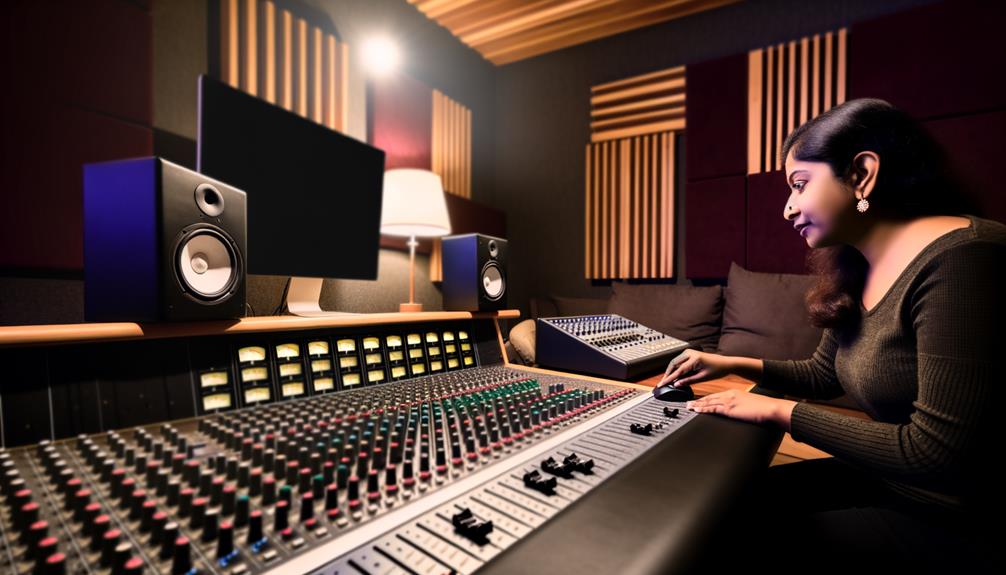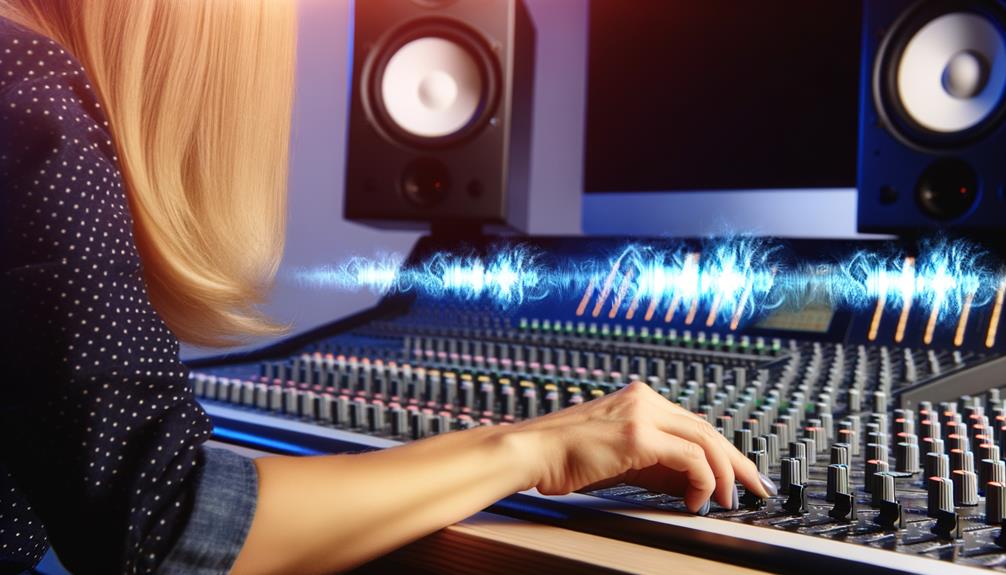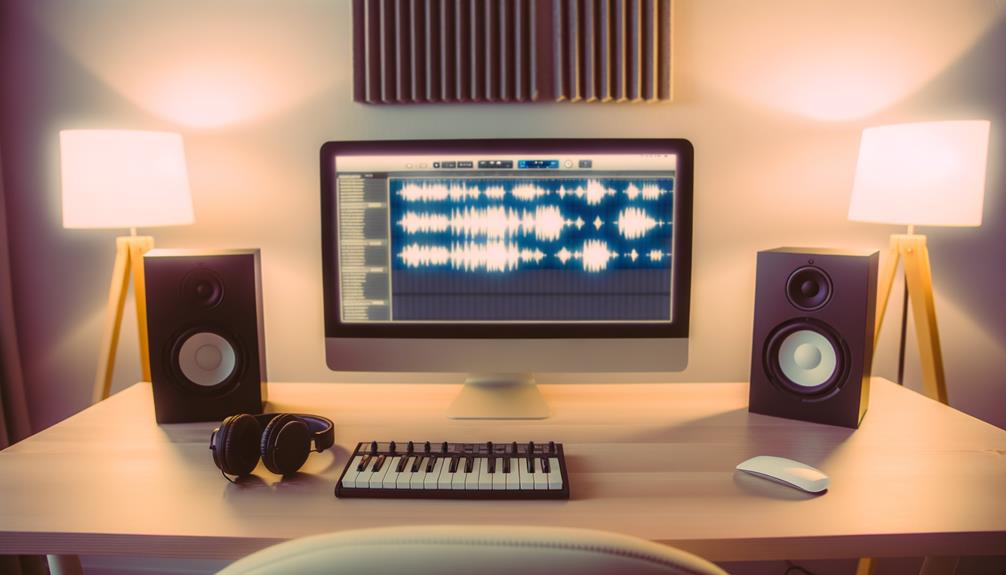Subtotal: £0.00
To achieve audio excellence, you can’t go wrong with these five essential analog tools. First, the SSL G-Series Bus Compressor is perfect for gluing your mix elements. Next, sculpt frequencies beautifully with the Pultec EQP-1A. For dynamic processing, the Universal Audio LA-2A delivers with its unique electro-optical attenuator system. To add warmth and character, consider the Studer A800, a staple in professional recording. Finally, enhance your mix’s spatial depth with an analog summing mixer like those equipped with warm, harmonic-rich transformers. Exploring further will uncover detailed benefits and specific applications for each tool in your studio setup.
Key Takeaways
- SSL G-Series Bus Compressor is ideal for gluing mix elements together for a cohesive sound.
- Universal Audio LA-2A excels in smooth, natural compression through its electro-optical attenuator system.
- Pultec EQP-1A analog equalizer is renowned for its ability to sculpt frequencies with warmth and musicality.
- Studer A800 tape machine is celebrated for its reliability and warm, analog sound characteristics.
- Analog summing mixers, like those with tube enhancements, increase spatial separation and add harmonic depth to mixes.
Essential Analog Compressors
Analog compressors, indispensable for dynamic control and sound shaping, provide a warm, natural compression essential in music production and mastering. You’ll find that these devices, through their classic circuits, not only preserve the integrity of the original sound but also enhance it by adding depth and character. Take, for instance, the SSL G-Series Bus Compressor, revered for its ability to glue mix elements together in a coherent and pleasing sound field. Its circuit design is a benchmark in the industry, offering a punchy, clear compression that’s both subtle and impactful.
Then there’s the Universal Audio LA-2A. This unit stands out with its electro-optical attenuator system, providing smooth, natural compression. Its tube-driven design adds a cherished warmth to vocals and other lead instruments, making it a staple in many top studios. This classic hardware exemplifies how analog compressors can be crucial in achieving a polished, professional sound.
Moreover, these analog classics are increasingly being reimagined with modern twists. Enhanced connectivity options and updated components mean you’re equipped to integrate these timeless tools seamlessly into contemporary digital workflows, ensuring they remain central to audio production environments. These updates allow you to manage dynamics with precision while maintaining the sonic essence that only analog gear can provide.
Top Analog Equalizers
While analog compressors shape dynamics, equalizers like the Pultec EQP-1A excel in frequency sculpting, offering you the ability to enhance or attenuate specific audio elements with precision. Delving into analog EQ techniques, you’ll find that the manipulation of EQ frequency bands allows for meticulous adjustments that can transform a flat mix into a vibrant, dynamic expression.
Analog equalizers, characterized by their use of tubes, transistors, and transformers, provide a distinctive warmth and musicality. This natural sound character is vital for achieving a rich, full-bodied audio output. When adjusting analog EQ settings, it’s essential to start with subtle shifts, allowing the unique characteristics of the analog components to subtly influence the sound. For instance, boosting the low-end can add depth, while careful tweaking of the mid-range can bring out the vocals or lead instruments.
Studio EQ tips often highlight the importance of using high-quality analog equalizers to not only correct imbalances but also to creatively color the audio. This dual functionality makes them indispensable in professional recording environments. Remember, each adjustment you make with an analog equalizer can greatly impact the overall texture and impact of your mix, emphasizing the need for precision and thoughtful application.
Premium Analog Limiters
In the domain of mastering audio, top-tier analog limiters are essential for managing dynamic range and achieving peak loudness with minimal distortion. You’ll find these units integral in your mastering console, enhancing audio with their unique characteristics. Their integration not only smooths out peaks but also imbues your tracks with a richness that digital plugins struggle to emulate.
Here are four key attributes to visualize when considering premium analog limiters:
- High-Quality Components: These limiters are built with superior components that preserve audio integrity while pushing loudness to its limits. Think transformers and discrete amplification stages that offer unparalleled clarity and depth.
- Analog Saturation Techniques: They apply subtle harmonic distortion, which enriches the sound palette. This isn’t just about controlling dynamics; it’s about adding a sonic signature that can define a recording.
- Warm and Transparent Sound: The sound character is both warm and transparent, ensuring that enhancements are felt rather than overtly heard, maintaining your track’s original vibe.
- Mastering Console Integration: Seamlessly integrating with your mastering console, these limiters become a natural extension of your workflow, essential for real-time adjustments during the mastering process.
Key Vintage Tape Machines
Building on the foundation of premium analog limiters, let’s explore the impact of key vintage tape machines, which play a pivotal role in shaping the sound of professional recordings. You’ll find that mastering tape saturation techniques is essential for achieving those sought-after vintage tape sounds.
Take the Studer A800, for instance, renowned for its warm sound and reliability. It’s not just about the sound; regular tape machine maintenance, including precise tape machine alignment, guarantees its legendary status in professional studios. Similarly, the Ampex ATR-102 is favored for high-quality tape emulation. This machine allows you to select from different tape formulations, offering versatility in sonic characteristics.
Then there’s the Otari MTR-10, a robust unit known for its user-friendly controls and classic analog sound. Its durability ensures consistent performance, critical for studios requiring dependable output. The Sony APR-5000 stands out for its advanced tape transport system and exceptional signal-to-noise ratio, providing precise tape handling that’s critical for clean, high-quality recordings.
Lastly, the MCI JH-110 offers customizable tape speeds and EQ options, allowing you to tailor the output and explore diverse analog tape effects. Proper alignment and maintenance are key to fully exploiting its capabilities, guaranteeing a rich, full-bodied sound.
Best Analog Summing Mixers
Analog summing mixers, crucial for enhancing spatial separation and depth, utilize transformers to introduce a warm, harmonically rich sound to your mixes. These devices aren’t just about mixing tracks; they sculpt the audio by adding subtle nuances that digital platforms can’t fully replicate. You’ll notice transformer coloration and harmonic saturation play key roles in how each mixer brands your sound with a signature warmth and depth.
Imagine integrating one of these units into your studio setup. Here’s what it might look like:
- Glow of Tubes and VU Meters: Picture the gentle glow of tubes and the flickering of VU meters as they respond dynamically to the audio passing through the circuits.
- Tactile Knobs and Switches: Feel each adjustment with precision-engineered knobs and switches that let you tweak transformer settings and circuit options for ideal sound.
- Harmonic Richness: Hear the subtle harmonic saturation as it enhances the depth of your mixes, creating a three-dimensional soundstage.
- Circuit Symphony: Visualize the internal symphony of capacitors, resistors, and custom-wound transformers working in harmony to widen your mix and add that elusive analog magic.
Frequently Asked Questions
What Is the AI Tool to Enhance Audio Quality?
The AI tool you’re looking for to enhance audio quality utilizes AI audio restoration and neural network algorithms. VideoProc Vlogger effectively removes background noise and applies various filters and effects for precision audio enhancement.
What Software Improves Audio Quality?
You’ll find software like VideoProc Vlogger and SOUND FORGE Audio Cleaning Lab 2 enhances audio quality through advanced plugins and mastering techniques, refining clarity and depth in your digital audio productions.
How to Improve Sound Quality?
To improve sound quality, focus on precise speaker placement and effective acoustic treatment. These adjustments optimize audio dispersion and reduce unwanted reflections, essential for achieving clear and accurate sound reproduction in your environment.
What App Improves Audio Quality?
To enhance audio quality, consider apps like VideoProc Vlogger or Realtek Audio Manager that offer robust hardware integration and adapt to user preferences with precision-oriented features like noise removal and customizable equalizers.
Conclusion
As you refine your audio setup, remember the critical role these analog tools play. Compressors tighten dynamics, while equalizers shape your tonal balance.
Limiters are indispensable for peak control, preserving clarity under high stress. Don’t overlook vintage tape machines for that warm, classic sound, and consider summing mixers to blend tracks with unparalleled warmth and depth.
Integrating these tools will elevate your audio productions, ensuring professional, studio-quality sound in every project you undertake.





